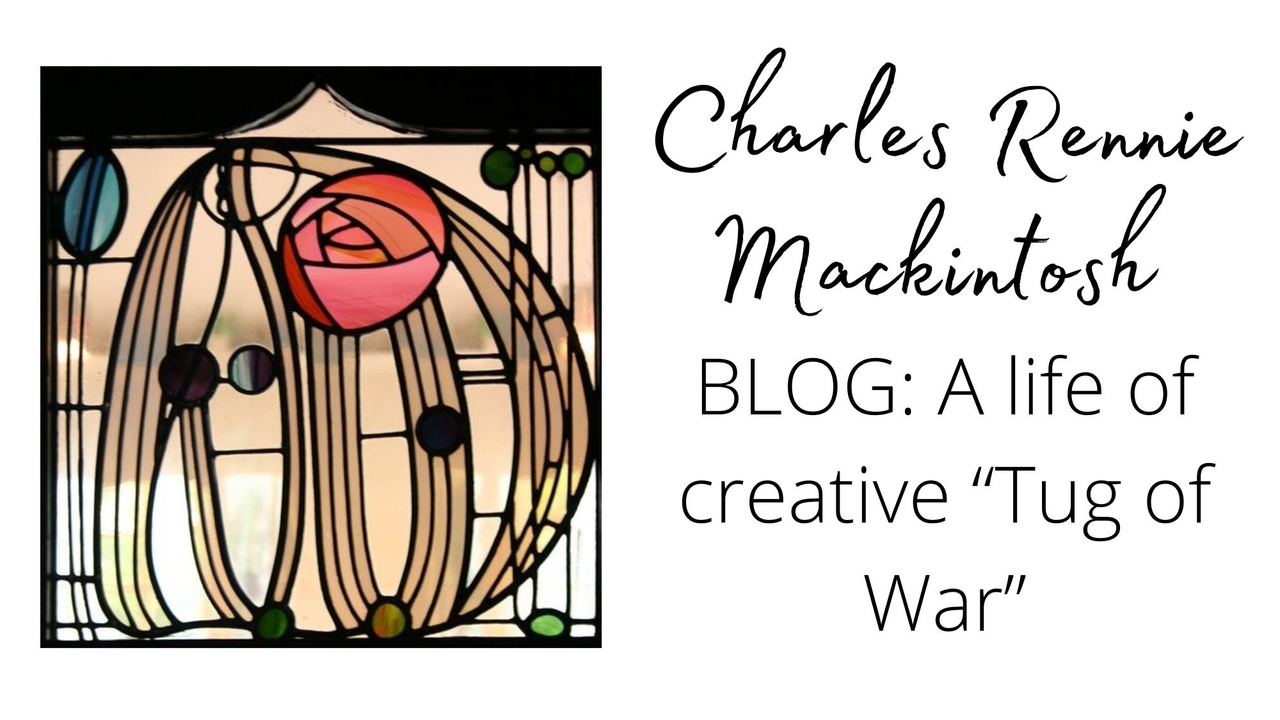Charle Rennie Mackintosh: A life of creative “Tug of War”
Sep 02, 2021
Charle Rennie Mackintosh was an architect, designer and artist. In addition to his iconic buildings, his body of work includes: Jewellery, graphics, wall decoration, paintings, vases, wood engraving, chairs cutlery, napkins, hat stands, beds, carpets, mirrors, wardrobes and clocks. He was pulled in a virtual “tug of war’ between the worlds of art, craft and architecture, talented at all of them, unable to really settle in any of them.
Born June 7th 1868, in a poky top floor flat, he was the 4th of 11 children. Was born McIntosh, start to call themselves Mackintosh with his fathers second marriage.
Solitary in childhood and coping with a disability (club foot) he developed an affection for cats and walking. Deemed academically ‘poor’ at school, he never got the hang of spelling and was only interested in drawing. It was clear from a young age he could see, identify and then draw solutions to problems. He had a winning charm but also a volatile character
vulnerable to fits of explosive rage, It is thought that he had Aspergers.
He started an apprenticeship as a draughtsman, in a firm of architects, Honeyman and Keppie, at the age of 16 in 1889. He received virtually no pay and his father had to back him financially for 5 years whilst he trained. It was during these years that whilst attending evening drawing classes at the Glasgow school of art. It is here that CRM’s tug of war began …..art vs architecture….and his father was against both!
Mackintosh’s Glasgow was the “rapidly growing, self-satisfied and dirty, second city of the
empire”. At the end of the 19th C, Local businessmen furnished their homes with the distinctive Glasgow Style, which was a lively and progressive movement. Glasgow School of art was flourishing and the city was undergoing an artistic renaissance, with a flourishing creative arts scene.
At the School CRM met his his colleague and friend Herbert Mc Nair and the women they were both to marry, sisters Margaret and Frances Macdonald. ‘The four’ collaborated on furniture, metalwork and illustration. Mackintosh often worked closely with Margaret on commissions for interiors.
Almost all his architectural work was produced in a short intense period, such as the ground breaking Glasgow School of Art. Although he gathered fame and appreciation for his architecture in Europe, it met with considerable indifference at home and his career soon declined.
Frequently mis-characterised as an Art Nouveau architect although he hated the term and the style! His work was firmly controlled, using clean lines and linear qualities. His schemes often contained ground breaking technology hydro-pneumatic lift and fire-resistant diatomite concrete flooring.
Mackintosh designed complete buildings including their foundations, ventilation systems, plumbing. He pioneered the complete integration of interior and exterior architecture. He demanded complete control, and there was no room for compromise often falling out with clients who did not agree with everything he wanted to do. He considers how we move between rooms and the interplay of light, texture, mood. Few private clients were sufficiently sympathetic to want his ‘total design’ of house and interior.
Throughout his career Mackintosh relied on just a handful of patrons and supporters. The Glasgow businesswoman Catherine Cranston proved to be one of his most influential and her series of tearoom interiors (designed and furnished between 1896-1917) provided him with a virtual freedom to experiment. Responsible for their ‘total design’ Mackintosh provided the tearooms with furniture (including the dramatic high-back chairs), light fittings, wall decorations and even the cutlery.
He was an incredible artist, spent hours painting delicate flowers with his acute powers of observation. Many of his floral paintings are labelled with where they were made…including his famous fritillaries from Walberswick. In 1923, when in his 50’s, he moved south of France which “signalled the end of Mackintosh’s three-dimensional career” and the last years of his life were spent painting. He died in London on 10 December 1928.
There are powerful silences in his story, where very little is known about him, few photos survive and none of his family in childhood. He had no children, his sisters son, was treated as his only surviving relative had absolutely no interest in Mackintosh and died long ago in a far away country,
Top fans of Mackintosh include
Brad Pitt: who is something of a Mackintosh aficionado, and has visited some of his work whilst he was filming in the city.
Peter Capaldi: a graduate of the GSA, recalled memories of his time at the art school. He said: “There is no greater symbol of the artistic spirit of Scotland than the Mackintosh Building.”
Create! art school are hosting an event on the life and work of CRM. It's a practical workshop about his use of Stained glass in his design. You can use pen and ink or watercolours for the workshop.
Want to join my FREE Pen and Watercolour course?

